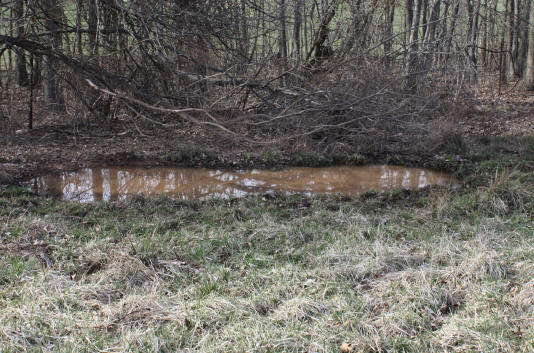Rusty Ryan
If you are a private property owner who owns woodlands than you need to first determine if your property includes vernal pools. Now is the time to get out and check to see if you have these pools. These pools can be located also by listening for an indicator species such as the Wood Frog. Once you’ve located the pool, you should limit any impact or
encroachment of the pool itself plus assure protection of the upland buffer for which the adults live most of the year. If you are considering having timber harvested from your property please let the forester know that you wish to have the harvest conducted in a way that protects the habitat.

Private landowners may wish to obtain a copy of Pennsylvania Wildlife No. 15 titled Vernal Ponds: Seasonal Habitats for Wildlife. This brochure can be obtained through your local Penn State Cooperative Extension or go online at http://pubs.cas.psu.edu.
Because of their temporary nature, these pools go unnoticed and therefore unprotected by the wetlands regulatory programs. The Pennsylvania Natural Heritage program is looking for volunteers to locate vernal pools throughout the Commonwealth. For more information, visit the web site at: www.paconserve.org/rc/sp.
Only when these pools are studied and located can they be protected from the various land activities (timber harvesting and land development activities) that threaten them.
If you are driving down a road on a warm and rainy winter evening and you observe live or dead frogs and salamanders along the road, this is a very good sign that a vernal pool is nearby. Sad as it may seem; these roads are obstacles for the migration of these species from their upland habitat to the vernal pools used for breeding. Note: Many places
throughout the country allow groups or individuals to post warning signs to motorists to avoid certain roads or be very cautious when utilizing these roads during rainy spring evenings. Some places have gone so far as to erect barriers parallel to the roads thus forcing the amphibians to enter a specially constructed access (pipe) so that they can safely get under the road
with minimal harm.
As a footnote to this, I tried unsuccessfully to get permission from a local municipality to erect some seasonal signs for a stretch of road that separates the upland home from the breeding area. www.vernalpool.org
Why should we protect these pools and the life they support? - Think of the amphibians as the canary in the mine. The canary warned man of health issues. The amphibians are nature’s true barometer of the health of the environment. When the amphibians start disappearing than us humans have some serious worrying to do.
Species Profile
Wood Frog – Like most of the indicator species, this frog species is seldom seen except for the brief time during the spring when the adults seek the pools for breeding purposes. Most of the year they take cover under various objects in the woods. The Wood Frog has a distinct call that has been compared to that of a quacking duck. The Wood Frog also
can be distinguished by a distinct black strip through the eye almost like the mask of a raccoon.
Another unique adaptation of these species but especially of the Wood Frog is the ability of these cold blooded species is there tolerance to freezing. Tests have been conducted on this frog and it appears this frog has an anti-freeze type solution that enables the blood and other tissues to withstand freezing and thawing which would kill most other
species of amphibians.
Spotted Salamander – The Spotted is the largest of the "mole" salamanders. This species is pretty much bluish black/black with yellow spots and can reach a length of nearly 8 inches. If the location is right and conditions are optimal this salamander species can be seen in the thousands as they seek out the pools to breed and lay eggs.
Note: The term mole salamander refers to the fact that these salamanders spend nearly all of their life underground only to venture out for breeding or foraging for food at night.
Marbled Salamander – The Marbled is our only fall breeding mole salamander and is also a dark salamander with distinct white blotches. The female will actually guard the eggs until such time the pools fill with water.
Jefferson’s Salamander – Of the three mole salamanders mentioned, the Jefferson Salamander is a pretty non descript salamander in terms of coloration and pattern. The Jefferson usually seeks out the pools the earliest and is well documented to migrate over snow in order to reach the pools to breed.
Fairy Shrimp – These very small shrimp (you won’t find these on the menu at Red Lobster) are the main food supply that the indicator species feed on. Uniqueness to this species is the ability of the eggs to lie dormant sometimes for years and hatch when the pools fill with water.
While most of us will trek through the woods in the coming weeks, most of us are unaware of one of natures most impressive migrations is undwerway.